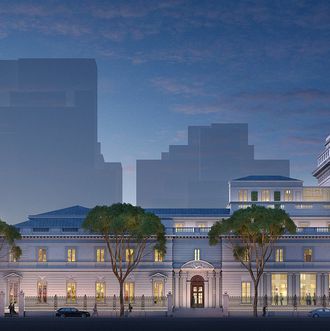
Preservationists all over the city must be nursing Champagne hangovers these days. A few weeks ago, a Brooklyn Heights group convinced a judge to pause construction of the Pierhouse development, which intrudes into residents’ views of their favorite bridge. Then another platoon persuaded the Landmarks Preservation Commission to leave The Four Seasons restaurant architecturally intact, even if the building’s owner, Aby Rosen, has vowed to evict it as a business. And now, a third ad-hoc organization has successfully bullied the Frick Museum into backing off its expansion plan, without any reasonable alternative. Hooray for tiny victories.
Once the bubbly has gone flat, I hope that those who care about fusing this city’s history and its future will take a good hard look at the puny battles they are fighting in the name of preservation. A few feet of bulkhead here, a glass partition there, a civilized if imperfect proposal to let visitors see a little more of the Frick’s off-limits glories — these are causes unworthy of the passions they have aroused, especially at a time when vast swaths of New York’s fabric and history are under more urgent threat.
The de Blasio administration is pushing a grand affordable housing program but doesn’t seem to care whether the buildings that result will do the city proud. Public-housing projects are deteriorating faster than they can be repaired. While landscape architects defend the minuscule and inaccessible garden that Russell Page wedged in alongside the Frick as a placeholder in 1977, parks all over the city are turning into dust bowls and sinkholes. A plague of glass eats away at the city’s masonry muscle, and a bloom of stupid midsize towers goes unnoticed. These are preservation issues, too, even though they don’t fall under the narrow purview of the 50-year-old Landmarks statute, and even though they are too big and broad and existential to excite the cilia of those who care only for authentic period detail.
I love the Frick, with its gilded intimacy and domestic hush. To drift through its galleries feels less like being a customer than a guest. I have also climbed the stairs and beheld the splendors of the second floor, and the chances are that you have not. Wouldn’t you like to? That access is part of what a sensitively designed renovation could yield. Many of those who recoiled at the idea of expanding the museum were reacting out of love. But anyone who cares about the Frick should work to enrich the experience, rather than yelling that barbarians are trying to destroy it. Critics compared the Frick’s expansion to MoMA’s, but the two plans and their contexts differ so much that using one to make a point about the other is wildly unhelpful. It’s true that not all museums need to expand, but by the same token, not all expansion plans are inherently bad.
The Frick backed down not because it saw the wisdom in its opponents’ arguments, but because it didn’t want to face years of debilitating lawsuits. The museum was right to shelve the stolid design by Davis Brody Bond, which never managed to turn constraints into triumph. But I trust that instead of giving up, administrators and board members will now confer with preservationists and Landmarks commissioners to help produce a more imaginative proposal. (For starters they should select a new architectural firm.) I wish, too, that the Frick’s protectors/enemies might stow their weapons of rhetoric, privilege, and pure feeling and resort to reason instead. And finally I hope that preservationists will redirect their ardor to defending the landscapes, texture, and customs of a city that sometimes needs to be rescued from its own energy and greed.






























